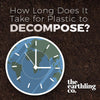
Everything is made with plastic now: your car, your home, your beauty products — even your beloved blue jeans. And each year, we produce more and more plastic, most of which is for single-use items. According to one study, humans have produced an estimated 8.3 billion tons of plastic since the 1950s, and nearly 80 percent of it ends up in landfills or the natural environment.
We know that plastic stays in the environment for a really long time, threatening the planet and all those who inhabit it. But how long does it take for plastic to decompose? What is the lifecycle of plastic? And what can we earthlings do to combat our growing plastic problem?
HOW LONG DOES IT TAKE FOR PLASTIC TO DECOMPOSE?
Most plastics don’t decompose at all. Decomposition is a complex process by which organic materials like food scraps, wood and paper are broken down into simpler organic compounds by bacteria and fungi.
Plastic isn’t organic (not entirely, anyway), so it technically can’t decompose. Most plastics are partially or fully synthetic, meaning they’re designed by humans and manipulated under extremely artificial conditions. Chemists also add water-repellents, UV inhibitors, plasticizers and other performance-enhancing additives to plastic, making them even more indestructible.

In order for plastic to decompose, it would need to be broken down by bacteria. But here’s the thing: most bacteria don’t like feeding on plastic. They simply haven’t had enough time to evolve in a way that would allow them to break down plastic.
SO, DOES PLASTIC LAST FOREVER?
For the most part, yes. But in recent years, researchers have discovered a few organisms that appear to eat certain types of plastic. One bacteria in particular, Ideonella sakaiensis, has been shown to break down PET, a type of plastic widely used to make plastic bottles.
That said, plastic-eating bacteria are by no means a feasible solution to our growing plastic pollutions problem. There’s simply too much plastic for microorganisms to eat.
Although most plastics don’t decompose, they do eventually break down into smaller and smaller pieces. These tiny pieces — known as microplastics — are extremely harmful to the environment and all who inhabit it.

THE LIFESPAN OF PLASTIC
Depending on the type of plastic and the environmental conditions, the degradation process can take anywhere from a few decades to a few hundred years. Here are the estimated degradation rates for some of the most commonly used plastics:

1. Plastic Bags: 20 Years
Despite many cities banning them, single-use plastic bags are still one of the most pervasive sources of plastic pollution. Every year, an estimated 500 billion plastic bags are used worldwide. Most of these plastic bags are made from polyethylene, a type of plastic that breaks down into tiny pieces that pollute our waterways, contaminate soil and enter our food chain when animals eat them. Thankfully, reusable plastic bags and cotton mesh produce bags have become a mainstream replacement for the eco-conscious shopper.
2. Plastic Straws: 200 Years
Did you know that more than 500 million plastic drinking straws are tossed in the trash every day? Plastic straws are too small to be recycled, so they’re destined for the landfill after just one use. If you love straws (or know someone who does), consider replacing them with stainless steel drinking straws that can be reused.
3. Plastic Water Bottles: 450 Years
Plastic bottles for beverages are one of the most recycled types of plastic in the world. Unfortunately, plastic beverage bottles are typically made from polyethylene terephthalate (PET), a clear and lightweight plastic that takes nearly 500 years to degrade. Makes you think twice about quenching your thirst with a single-use water bottle, doesn’t it?
4. Shampoo Bottles: 100 Years
Many shampoo bottles are made from high-density polyethylene (HDPE), a type of plastic that is incredibly strong and designed to endure higher temperatures than other plastics. Not only does HDPE take a long time to degrade, but studies have also detected estrogenic activity in HDPE, making it a potential hormone-disruptor.
If you want to avoid that scary mess and do right by Mother Earth, switch to a plastic-free shampoo bar. While you’re at it, pick up a plastic-free conditioner bar to complete the combo.
Shop Plastic-Free Shampoo

5. 6-Pack Plastic Rings: 400 Years
The plastic rings that secure our favorite canned beverages can be deadly to wildlife who may accidentally eat them or become entangled in the rings. Fortunately, many companies are phasing out plastic rings with non-plastic alternatives. If your favorite beverage company is still using plastic rings, consider writing them an email and encouraging them to go plastic-free.
6. Coffee Pods: 500 Years
K-cups and other coffee pods are a prime example of unnecessary single-use plastic. (You know things are bad when even their creator has stopped using them out of eco-guilt.) Coffee pods are terrible for the environment and frequently end up in waterways, where they break down and get ingested by wildlife.
7. Disposable Coffee Cups: 30 Years
Unless you bring your own reusable mug or cup, getting a quick caffeine fix at a coffee shop has an associated environmental impact too. Disposable coffee cups usually have a thin, plastic film on the inside to keep them from getting soggy, which makes the cup impossible to recycle.
8. Plastic Cups: 450 Years
Want to reduce your carbon footprint? Put down the red Solo cup (and all other plastic cups for that matter). Disposable cups are made from durable plastics that take nearly 500 years to break down in landfills. Think about it this way: Every red Solo cup you’ve ever partied with will outlive you, your grandchildren and their children.
9. Disposable Diapers: 500 Years
Tiny babies go through a lot of diapers. In fact, Americans throw away 27.5 billion disposable diapers every year. Organic cotton cloth diapers are a much better option for the environment — and your wallet!
10. Plastic Toothbrushes: 500 Years
Plastic toothbrushes are primarily made from polypropylene and nylon, two incredibly strong plastics that are derived from fossil fuels. And Americans throw away one billion of them every year. If you want to do your part to help, make the switch to a bamboo toothbrush and encourage your friends and family to do the same.

WHAT HAPPENS TO ALL THAT PLASTIC?
Sadly, the final destination for most plastics is a landfill. There, plastic (along with other waste) is typically sealed under a rubber and clay barrier to prevent liquids from escaping. If plastic waste isn’t buried, it’s destroyed via incineration — a process that is often criticized for creating harmful dioxins that can potentially leak into the environment. Neither option is ideal since both create greenhouse gases that heat the world and contribute to climate change.
Landfills aren’t the only place that plastic ends up, however. Every year, an average of 8.8 million tons of plastic finds its way into our oceans where it threatens the health of marine wildlife. And while you may have seen images of vast garbage patches in the sea, that’s just the tip of the iceberg. Most plastics that are lurking below the ocean surface are microplastics that you can barely see.
THE PROBLEM WITH PLASTIC RECYCLING
In general, the concept of recycling is wonderful. But there are a few problems when it comes to recycling plastic. According to the Environmental Protection Agency, only 10 percent of plastics are ever recycled. This isn’t just due to consumer behavior. Many types of plastic can’t be recycled at all.
Another problem with recycling plastic? Unlike glass and aluminum which can be recycled again and again without ever losing their quality, plastic doesn’t retain its value after going through the recycling process. It’s converted into a lower-quality product until it eventually ends up in a landfill or the natural environment.
To be clear, this isn’t to say that you should stop recycling your plastic products. Recycling plastic can help conserve fossil fuels that are used to manufacture it in the first place. But since plastic can’t participate in a circular economy, it’s better to make the switch to plastic-free products and avoid plastic altogether.

HOW CAN WE ADDRESS THE PLASTIC POLLUTION CRISIS?
We know all of this information may seem overwhelming, but it’s important. You should feel proud for taking the necessary step to be an educated earthling!
With your newfound knowledge, here are some ways you can help combat plastic waste:
1. Give up single-use plastics.
Not only do single-use plastics require a lot of resources and energy to produce, but they’re only used once before they’re thrown away. Swap out single-use items with reusable alternatives. Here are some of our favorite eco-friendly swaps:
- Swap single-use water bottles with a reusable bottle.
- Swap Ziploc bags for silicone snack bags.
-
Swap plastic takeout utensils with reusable bamboo utensils.
2. Recycle what you can.
Recycling rates are abysmally low, even in the United States. Take the time to learn about your city’s recycling program and do your part. Every little bit helps!

3. Make your kitchen more sustainable.
The kitchen is a big source of plastic waste. To make mealtime more sustainable, look for plastic-free alternatives to your kitchen essentials. Kickstart your eco-friendly makeover by reusing glass jars as food storage. Invest in long-lasting cookware like cast iron. Wash your dishes the plastic-free way by using solid dish soap and a wooden dish brush.
Shop Solid Dish Soap
4. Participate in (or host) a plastic cleanup.
Grab a friend and get involved in a local cleanup activity. When your coworkers or schoolmates ask you the question, “What did you do this weekend?” — use the opportunity to talk a little about the problem and why it matters to you.
5. Support legislation that upholds environmental justice.
There are many ways to be politically active around environmental justice. You can write to your elected representatives and encourage them to pass environmental legislation that moves us towards a more sustainable world. Or, join eco-friendly marches and protests.
6. Be a conscious consumer.
The money you spend can have a far-reaching impact on the lifespan of businesses and companies you purchase from, so choose wisely! Pledge to be a more conscious consumer by thinking about how your buying practices might affect the world. Research brands before you buy from them and support brands with business practices that are aligned with your values. (Here at The Earthling Co., our shipping is 100% plastic-free!)
7. Hold corporations responsible for plastic reduction goals.
Corporations are responsible for a massive amount of plastic waste. In fact, six billion tons of plastic waste are generated each year by just four companies: Coca-Cola, Mars, Nestle and Danone. While many companies have pledged to reduce their reliance on plastic packaging, we need to keep them accountable. Write letters to your state congressperson about corporations that use excessive plastic packaging and be vocal on social media (tip: tag the company to get their attention). Keep the pressure on!
8. Stay positive.
The more you learn about the plastic pollution problem, the easier it is to feel overwhelmed. Try not to beat yourself up if you make a mistake on your plastic-free journey. Nobody expects you to be perfect!

IT’S TIME TO BREAK FREE FROM PLASTIC
To recap, the answer to the question, “How long does plastic take to decompose?” can be summed up in one word: forever. Different types of plastic degrade at varying rates into tiny pieces (known as microplastics), which litter the land, foul up our waterways, harm animals and pose a threat to human health.
Here at The Earthling Co., we believe that we have the power to create a more sustainable and harmonious world. That’s why we make products that are safer for you, the planet and all those who inhabit it. Browse our plastic-free products and let us help you start your low-waste journey!
Image Sources
awsome design studio/Shutterstock.com
New Africa/Shutterstock.com
chaiyapruek youprasert/Shutterstock.com
Olga Miltsova/Shutterstock.com
MOHAMED ABDULRAHEEM/Shutterstock.com
Inside Creative House/Shutterstock.com













